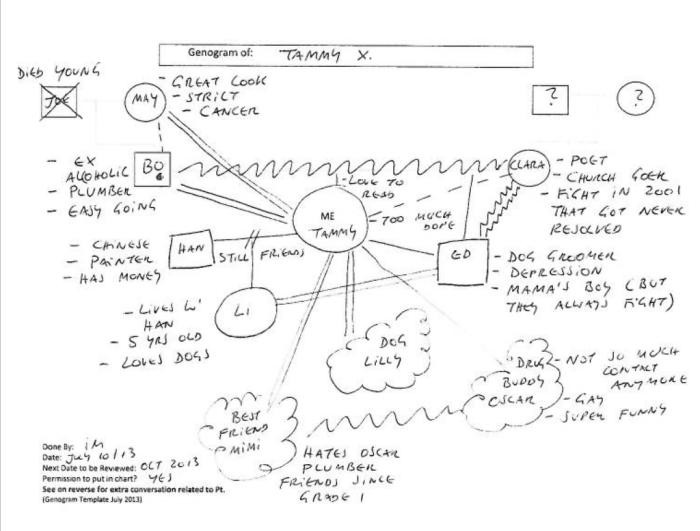Genograms help shed light on the intricate web of family relationships and health patterns, providing valuable insights into our past, present, and future.
These visual representations of family trees offer a unique perspective, revealing hidden connections, inherited health risks, and the impact of trauma and resilience.
Family Dynamics and Relationships

Genograms are powerful tools for visualizing and analyzing the dynamics within families. They provide a comprehensive overview of family relationships, including patterns of communication, emotional bonds, and conflicts.
By mapping out the relationships between family members, genograms can reveal hidden connections and patterns that may not be immediately apparent. For example, a genogram may show that a child has a closer relationship with a grandparent than with their own parents, or that there is a history of conflict between two siblings.
Patterns of Communication
Genograms can illustrate how communication patterns within a family affect relationships. For instance, a genogram may show that there is a lack of communication between two family members, or that communication is often indirect or through a third party.
Emotional Bonds
Genograms can also reveal the emotional bonds between family members. For example, a genogram may show that there is a strong bond between a parent and child, or that there is a history of estrangement between two siblings.
Conflicts
Genograms can also be used to identify and analyze conflicts within families. For example, a genogram may show that there is a history of conflict between two family members, or that there is a pattern of conflict that repeats itself across generations.
Health and Medical History

Genograms play a crucial role in understanding inherited health conditions by mapping the patterns of disease transmission within families. By examining the medical history of multiple generations, genograms can help identify genetic predispositions, environmental factors, and lifestyle choices that may contribute to health risks.
Identifying Risk Factors
Genograms can reveal patterns of inheritance for specific diseases, such as heart disease, diabetes, or certain types of cancer. By tracing the occurrence of these conditions across generations, healthcare professionals can assess the likelihood of individuals developing similar health issues based on their family history.
This information can inform preventive measures, such as regular screenings, lifestyle modifications, or genetic testing.
Mental Health and Well-being: Genograms Help Shed Light On

Genograms offer a comprehensive tool to explore mental health issues within families. By mapping patterns of mental illness, substance abuse, and other psychological disorders across generations, genograms help clinicians identify potential genetic and environmental factors contributing to an individual’s mental health.
Case Study: Anxiety and Depression
In one case study, a genogram revealed a strong family history of anxiety and depression. The individual seeking treatment had struggled with anxiety and depressive episodes for years. By examining the genogram, the therapist identified that both the individual’s parents and grandparents had experienced similar symptoms.
This information suggested a potential genetic predisposition to these mental health conditions. The therapist used this knowledge to develop a treatment plan that included medication, therapy, and lifestyle changes tailored to the individual’s genetic profile.
Trauma and Resilience

Genograms can uncover the impact of trauma on individuals and families by highlighting patterns of adversity and resilience across generations. They can identify individuals who have experienced multiple traumatic events, as well as the ways in which these experiences have shaped their lives and relationships.
Patterns of Resilience
Genograms can also help identify patterns of resilience and coping mechanisms within families. By examining how individuals have responded to adversity, genograms can shed light on the protective factors that have helped them to overcome challenges. This information can be invaluable for developing interventions and support systems that promote resilience in individuals and families affected by trauma.
Cultural and Social Influences

Genograms offer a powerful tool to illuminate the profound influence of culture and society on family relationships. By mapping out the family tree and incorporating information about cultural background, values, and traditions, genograms provide a rich tapestry that reveals the ways in which external factors shape family dynamics.
For instance, a genogram may reveal cultural norms regarding family roles and responsibilities. In some cultures, extended family members play a significant role in raising children, while in others, the nuclear family is more prevalent. Genograms can also shed light on cultural values related to marriage, divorce, and inheritance, which can have a profound impact on family relationships.
Cross-Cultural Perspectives
Genograms are particularly valuable in understanding the complexities of cross-cultural families. By comparing genograms from different cultures, researchers and clinicians can identify cultural variations in family structure, communication patterns, and conflict resolution strategies. This knowledge can help professionals provide culturally sensitive care and support to families from diverse backgrounds.
Genograms help shed light on family patterns, like in the case of Farris v. Glen Alden Corp. , where they revealed a history of work-related injuries. This case demonstrates how genograms can illuminate generational trauma and its impact on health outcomes, further emphasizing their value in unraveling the complexities of family dynamics.
Case Example, Genograms help shed light on
Consider a genogram of a family from a collectivist culture. This genogram may reveal a strong emphasis on interdependence, with family members closely connected and supporting each other. In contrast, a genogram of a family from an individualistic culture may show a greater focus on independence, with family members having more autonomy and less reliance on extended family.
Ethical Considerations

The use of genograms raises several ethical concerns that must be addressed to ensure the privacy, confidentiality, and well-being of individuals and families. These considerations include:
Confidentiality and Privacy
- Genograms contain sensitive information about individuals and their families, including health history, mental health conditions, and personal relationships.
- It is crucial to maintain the confidentiality of this information and to protect it from unauthorized access or disclosure.
- Informed Consent: Individuals should be fully informed about the purpose of the genogram, how their information will be used, and who will have access to it.
- Consent should be obtained from all individuals represented in the genogram, or from their legal guardians if they are unable to provide consent themselves.
Informed Consent
- Individuals should be given clear and understandable information about the purpose of the genogram, the potential benefits and risks, and their rights as participants.
- They should have the opportunity to ask questions and to make informed decisions about whether or not to participate.
- Informed consent should be documented in writing and signed by the participant.
Questions and Answers
What are the benefits of using genograms?
Genograms provide a comprehensive overview of family relationships and health patterns, helping individuals identify risks, patterns, and strengths within their family.
How can genograms help with mental health issues?
Genograms can reveal patterns of mental health conditions within families, aiding in diagnosis and treatment planning.
Are genograms confidential?
Yes, genograms should be treated with the utmost confidentiality and privacy.